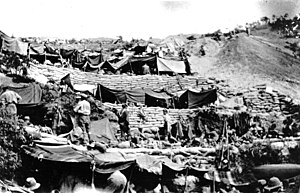Day 1 – Istanbul to Gallipoli
 In the early morning we will drive west, heading towards the Aegean Sea. We will visit Gallipoli
on the way
*Gallipoli and The Dardanelles — After our lunch we will
stop to visit Gallipoli, a place of fierce World War 1 fighting between
Allied forces and the Turks. At ANZAC Cove thousands lost their lives in
one fateful dawn morning. We will also see other famous battle sites of
World War 1 in this area, such as Lone Pine and Chunuk Bair. From here
we go to a ferry and cross the Dardanelle. For World War 1 buffs, you
will know the Dardanelle Straits were a strategic crossing point for the
allied armies to cross from Europe to Asia Minor.
*Canakkale will be
our final destination for today and where we will spend the evening.
After dinner, you might want to stroll the harbor walk and experience
the local culture. Overnight in CANAKKALE
In the early morning we will drive west, heading towards the Aegean Sea. We will visit Gallipoli
on the way
*Gallipoli and The Dardanelles — After our lunch we will
stop to visit Gallipoli, a place of fierce World War 1 fighting between
Allied forces and the Turks. At ANZAC Cove thousands lost their lives in
one fateful dawn morning. We will also see other famous battle sites of
World War 1 in this area, such as Lone Pine and Chunuk Bair. From here
we go to a ferry and cross the Dardanelle. For World War 1 buffs, you
will know the Dardanelle Straits were a strategic crossing point for the
allied armies to cross from Europe to Asia Minor.
*Canakkale will be
our final destination for today and where we will spend the evening.
After dinner, you might want to stroll the harbor walk and experience
the local culture. Overnight in CANAKKALE
Day 2 – Gallipoli to Kusadasi
 We continue our scenic drive along the Aegean, stopping for photo
opportunities and perhaps to indulge the taste buds at one of the many
farmer road side stands that sell olives, figs, seasonal fruit and
pistachios. We then will head east towards our first site of the day.
Sites you’ll see today
*Troy –is the ancient site written about by
Homer in the Iliad. It dates back as far as 3000 BC and has been the
site of nine different cities through the thousands of years it has
existed. As you enter the site a large wooden Trojan horse dominates
your view. You will definitely want to climb up and get your picture
taken!
After lunch you will depart from Canakkale, driving along the
Aegean Sea down to Kusadasi, evening arrival in Kusadasi, Check in the
hotel, Overnight stay.
We continue our scenic drive along the Aegean, stopping for photo
opportunities and perhaps to indulge the taste buds at one of the many
farmer road side stands that sell olives, figs, seasonal fruit and
pistachios. We then will head east towards our first site of the day.
Sites you’ll see today
*Troy –is the ancient site written about by
Homer in the Iliad. It dates back as far as 3000 BC and has been the
site of nine different cities through the thousands of years it has
existed. As you enter the site a large wooden Trojan horse dominates
your view. You will definitely want to climb up and get your picture
taken!
After lunch you will depart from Canakkale, driving along the
Aegean Sea down to Kusadasi, evening arrival in Kusadasi, Check in the
hotel, Overnight stay.
 In the early morning we will drive west, heading towards the Aegean Sea. We will visit Gallipoli
on the way
*Gallipoli and The Dardanelles — After our lunch we will
stop to visit Gallipoli, a place of fierce World War 1 fighting between
Allied forces and the Turks. At ANZAC Cove thousands lost their lives in
one fateful dawn morning. We will also see other famous battle sites of
World War 1 in this area, such as Lone Pine and Chunuk Bair. From here
we go to a ferry and cross the Dardanelle. For World War 1 buffs, you
will know the Dardanelle Straits were a strategic crossing point for the
allied armies to cross from Europe to Asia Minor.
*Canakkale will be
our final destination for today and where we will spend the evening.
After dinner, you might want to stroll the harbor walk and experience
the local culture. Overnight in CANAKKALE
In the early morning we will drive west, heading towards the Aegean Sea. We will visit Gallipoli
on the way
*Gallipoli and The Dardanelles — After our lunch we will
stop to visit Gallipoli, a place of fierce World War 1 fighting between
Allied forces and the Turks. At ANZAC Cove thousands lost their lives in
one fateful dawn morning. We will also see other famous battle sites of
World War 1 in this area, such as Lone Pine and Chunuk Bair. From here
we go to a ferry and cross the Dardanelle. For World War 1 buffs, you
will know the Dardanelle Straits were a strategic crossing point for the
allied armies to cross from Europe to Asia Minor.
*Canakkale will be
our final destination for today and where we will spend the evening.
After dinner, you might want to stroll the harbor walk and experience
the local culture. Overnight in CANAKKALEDay 2 – Gallipoli to Kusadasi
 We continue our scenic drive along the Aegean, stopping for photo
opportunities and perhaps to indulge the taste buds at one of the many
farmer road side stands that sell olives, figs, seasonal fruit and
pistachios. We then will head east towards our first site of the day.
Sites you’ll see today
*Troy –is the ancient site written about by
Homer in the Iliad. It dates back as far as 3000 BC and has been the
site of nine different cities through the thousands of years it has
existed. As you enter the site a large wooden Trojan horse dominates
your view. You will definitely want to climb up and get your picture
taken!
After lunch you will depart from Canakkale, driving along the
Aegean Sea down to Kusadasi, evening arrival in Kusadasi, Check in the
hotel, Overnight stay.
We continue our scenic drive along the Aegean, stopping for photo
opportunities and perhaps to indulge the taste buds at one of the many
farmer road side stands that sell olives, figs, seasonal fruit and
pistachios. We then will head east towards our first site of the day.
Sites you’ll see today
*Troy –is the ancient site written about by
Homer in the Iliad. It dates back as far as 3000 BC and has been the
site of nine different cities through the thousands of years it has
existed. As you enter the site a large wooden Trojan horse dominates
your view. You will definitely want to climb up and get your picture
taken!
After lunch you will depart from Canakkale, driving along the
Aegean Sea down to Kusadasi, evening arrival in Kusadasi, Check in the
hotel, Overnight stay.














